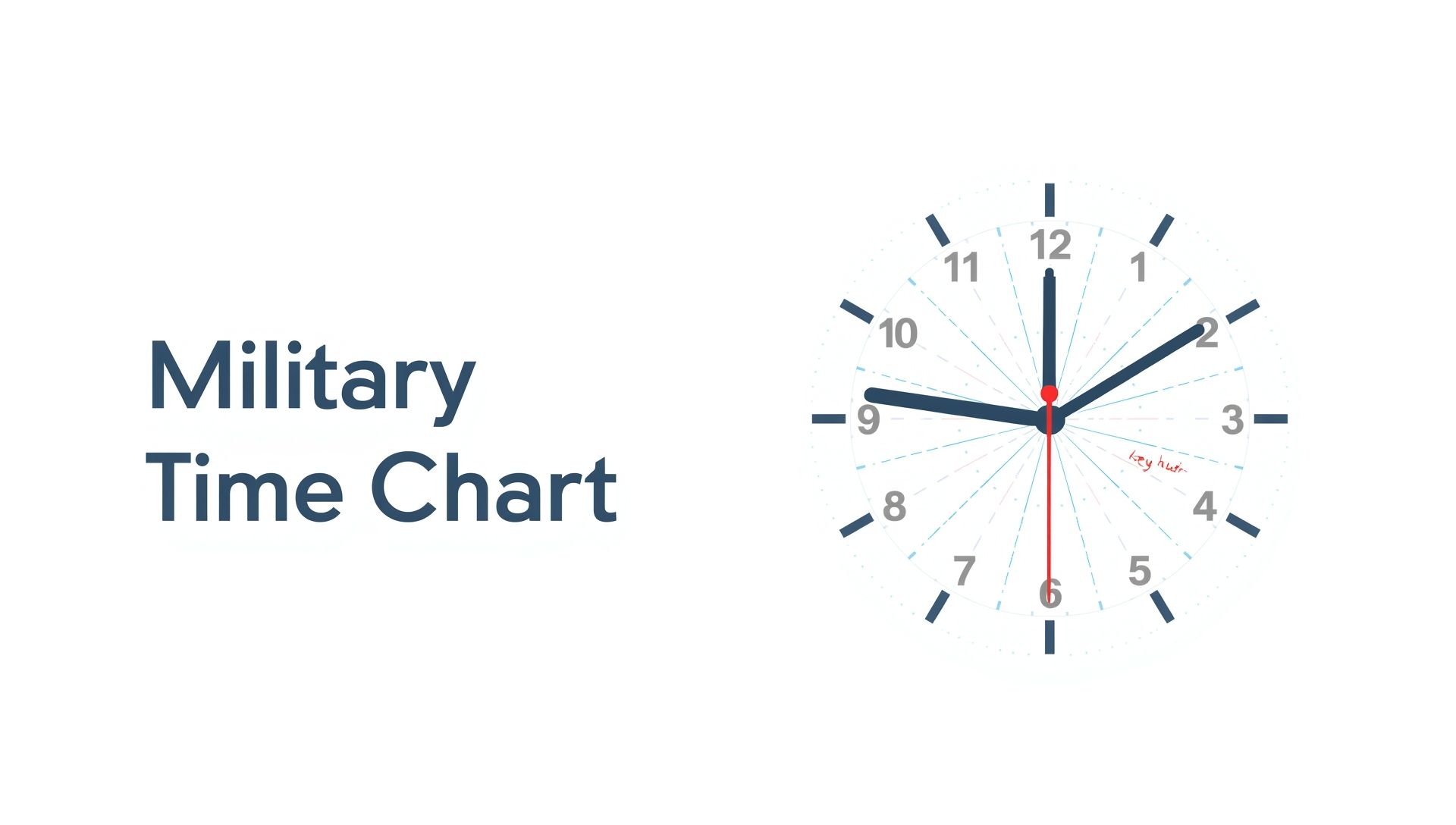Understanding Time with a Military Time Chart
Military time might seem strict at first glance, but once you understand it, it makes perfect sense. It’s built for clarity, not confusion. No AM or PM, no second guessing whether “seven” means morning or evening. This format keeps everyone, from pilots to doctors, perfectly in sync across the planet.
What Military Time Really Means
Military time is a method of expressing time using a 24-hour clock. Instead of repeating numbers twice a day, it counts continuously from 0000 (midnight) to 2359 (11:59 PM). This system is precise, efficient, and eliminates the need for “AM” and “PM.”
If you’d like a full breakdown of how every hour converts, you can use the Military Time Conversion Chart for instant reference.
How It Differs from the Regular Clock
- The 12-hour clock resets twice per day (once at noon and once at midnight).
- The 24-hour system keeps counting, making 1 PM become 13:00, 2 PM become 14:00, and so on.
- Midnight starts at 0000 and the day ends at 2359 before resetting again.
The 24-hour clock is widely used across the world, especially in transportation, healthcare, and data systems, while military time is used for precise verbal communication in the military and emergency response fields.
Conversion Basics
Here’s how to convert between the two systems easily:
- Morning times (12 AM to 11:59 AM) remain mostly the same. Example: 7:00 AM → 0700.
- Afternoon times (1 PM to 11:59 PM) add 12 to the hour. Example: 5:00 PM → 1700.
- Midnight resets to 0000, not 12:00 AM.
- No colon is used. Instead of 14:30, it’s written 1430.
For a live reference on your current zone, you can visit time.now to see the 24-hour display in action.
Conversion Table
| 12-Hour Clock | 24-Hour Clock | Military Format |
|---|---|---|
| 12:00 AM | 00:00 | 0000 |
| 6:00 AM | 06:00 | 0600 |
| 12:00 PM | 12:00 | 1200 |
| 3:00 PM | 15:00 | 1500 |
| 9:00 PM | 21:00 | 2100 |
| 11:59 PM | 23:59 | 2359 |
NATO Phonetic Alphabet
Military time communication often uses the NATO phonetic alphabet to prevent misunderstandings. Each letter of the alphabet has a corresponding word that’s easy to recognize even over static-filled radios.
| Letter | Phonetic Word | Pronunciation |
|---|---|---|
| A | Alfa | AL-fah |
| B | Bravo | BRAH-voh |
| C | Charlie | CHAR-lee |
| D | Delta | DELL-tah |
| E | Echo | ECK-oh |
| F | Foxtrot | FOKS-trot |
| G | Golf | GOLF |
| H | Hotel | hoh-TELL |
| I | India | IN-dee-ah |
| J | Juliett | JEW-lee-ett |
| K | Kilo | KEY-loh |
| L | Lima | LEE-mah |
| M | Mike | MIKE |
| N | November | no-VEM-ber |
| O | Oscar | OSS-car |
| P | Papa | pah-PAH |
| Q | Quebec | keh-BECK |
| R | Romeo | ROW-me-oh |
| S | Sierra | see-AIR-rah |
| T | Tango | TANG-go |
| U | Uniform | YOU-nee-form |
| V | Victor | VIK-tor |
| W | Whiskey | WISS-key |
| X | X-ray | EKS-ray |
| Y | Yankee | YANG-kee |
| Z | Zulu | ZOO-loo |
Mapping Military Time Zones to UTC
Each military time zone corresponds to a letter (A through Z, excluding J). The letters represent offsets from Coordinated Universal Time (UTC). Zulu, or “Z,” is UTC itself. These zones are critical for global operations and navigation. Below is a colorful table linking them to their UTC offsets.
For live offsets and current local times, check time.now UTC Time Zones.
| Zone Letter | Phonetic Name | UTC Offset | Link |
|---|---|---|---|
| Y | Yankee | UTC−12 | UTC−12 |
| X | X-ray | UTC−11 | UTC−11 |
| W | Whiskey | UTC−10 | UTC−10 |
| V | Victor | UTC−9 | UTC−9 |
| U | Uniform | UTC−8 | UTC−8 |
| T | Tango | UTC−7 | UTC−7 |
| S | Sierra | UTC−6 | UTC−6 |
| R | Romeo | UTC−5 | UTC−5 |
| Q | Quebec | UTC−4 | UTC−4 |
| P | Papa | UTC−3 | UTC−3 |
| O | Oscar | UTC−2 | UTC−2 |
| N | November | UTC−1 | UTC−1 |
| Z | Zulu | UTC±0 | UTC±0 |
| A | Alfa | UTC+1 | UTC+1 |
| B | Bravo | UTC+2 | UTC+2 |
| C | Charlie | UTC+3 | UTC+3 |
| D | Delta | UTC+4 | UTC+4 |
| E | Echo | UTC+5 | UTC+5 |
| F | Foxtrot | UTC+6 | UTC+6 |
| G | Golf | UTC+7 | UTC+7 |
| H | Hotel | UTC+8 | UTC+8 |
| I | India | UTC+9 | UTC+9 |
| K | Kilo | UTC+10 | UTC+10 |
| L | Lima | UTC+11 | UTC+11 |
| M | Mike | UTC+12 | UTC+12 |
Living by the 24-Hour Rhythm
Once you adapt to the 24-hour format, time feels smoother. There’s no second guessing. Your calendar, travel, and work schedules line up perfectly across countries. Understanding military time helps you stay coordinated and in control, wherever you are on the planet.
It’s not just a system. It’s a global language of precision that turns every hour into a shared point of reference.
